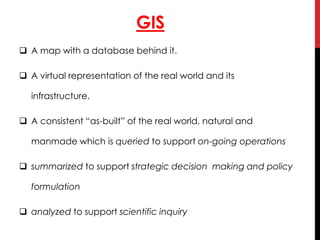Application of gis & rs in urban planning
- 1. APPLICATION OF REMOTE SENSING AND GIS IN URBAN PLANNING PRESENTED BY GEM GEORGE JACOB SEMESTER 1, M.PLAN SAP CAMPUS, ANNA UNIVERSITY, CHENNAI
- 2. Acquiring information about an object without touching the object itself. Acquired data is digitized and processed into image. Captures spatial (area), spectral (colour)and temporal (time) datas with accuracy, speed and cost effective on a repetative basis. REMOTE SENSING
- 3. URBAN PLANNING - APPLICATIONS OF RS
- 4. URBAN PLANNING - APPLICATIONS OF RS Important source of data for urban landuse/land cover mapping Environmental monitoring helps in encroaching urban problems even of very small magnitude.
- 5. URBAN PLANNING - APPLICATIONS OF RS Digitization of planning basemaps facilitated updating of basemaps whereverchanges have taken place in terms of land development etc. Superimposition of any two digital maps which are on two different scales is feasible. Superimposition of revenue maps on basemaps with reasonable accuracy is great advantage compared to manually done jobs.
- 6. URBAN PLANNING - APPLICATIONS OF RS • Study urban growth/sprawl and trend of growth • Updating and monitoring using repetitive coverage • Study of urban morphology, population estimation • Space use surveys in city centers • Slum detection, monitoring and updating • Study of transportation system and important aspects both in static and dynamic mode • Site suitability and catchments area analysis • Study of open/vacant space.
- 8. GIS-WHAT IS IT? Geographic/Geospatial Information information about places on the earth’s surface knowledge about “what is where when” (Don’t forget time!) Geographic/geospatial: synonymous GIS--what’s in the S? • Systems: the technology • Science: the concepts and theory • Studies: the societal context
- 9. GIS DATA TYPES – SPATIAL & ATTRIBUTE Spatial - the absolute and relative location of Geographic features. Attribute data – which describes the characteristics of the spatial features. characteristics can be quantitative and/or qualitative in nature. Attribute data is often referred to as tabular data.
- 10. GIS A map with a database behind it. A virtual representation of the real world and its infrastructure. A consistent “as-built” of the real world, natural and manmade which is queried to support on-going operations summarized to support strategic decision making and policy formulation analyzed to support scientific inquiry
- 11. GIS GIS TECHNIQUE PLANNING APPLICATION OVERLAYING LAND SUITABILITY, LANDUSE CHANGE DETECTION BUFFERING LOCATION ANALYSIS (police station, education etc) ACCESIBILITY TO TRANSPORTATION ( to find inaccessible areas) OPTIMAL ROUTE ANALYIS In terms of time, distance, relevance, safety
- 14. GIS IN URBAN PLANNING, MANAGEMENT & POLICY • Zoning, subdivision planning • Land acquisition • Economic development • Code enforcement • Housing renovation programs • Emergency response • Crime analysis • Tax assessment
- 15. URBAN PLANNING - APPLICATIONS OF GIS Area monitoring (both on a sectoral and integral basis) Regional potential and feasibility analyses. Site selection studies Alternate plans are generated (flexible design, optimization and evaluation tools)
- 16. URBAN PLANNING - APPLICATIONS OF GIS Documentation of spatial plans and in the approval process for the development, building and installation permit. Land management and land use planning issues including the interpretation and formulation of land use policy. Land-use policy can be interpreted within GIS using a modelling approach.
- 17. GEOGRAPHIC INFORMATION TECHNOLOGIES Global Positioning Systems (GPS) • a system of earth-orbiting satellites which can provide precise (100 meter to sub-cm.) location on the earth’s surface (in lat/long coordinates or equiv.) Remote Sensing (RS) • use of satellites or aircraft to capture information about the earth’s surface • Digital ortho images a key product (map accurate digital photos) Geographic Information Systems (GIS) • Software systems with capability for input, storage, manipulation/analysis and output/display of geographic (spatial) information. GPS and RS are sources of input data for a GIS. A GIS provides for storing and manipulating GPS and RS data.
- 18. CONCLUSION The present study indicates the uses of Remote Sensing and Geographic Information System for spatial planning. very easy to use analysis and visualization tools. Rapid development in city poses several challenges including problems associated with urbanization for urban managers and policy makers. Meeting these challenges requires access to timely and reliable information.
- 19. REFERENCES Remote Sensing and Urban Analysis, Taylor and Francis Publications, London. Patkar, V.N. (2003), “Directions for GIS in Urban Planning” Tiwari, D.P. (2006), Remote Sensing and GIS for efficient Urban Planning, GIS Development. GIS for Urban and Regional Planning, ESRI
- 20. THANK YOU!



















